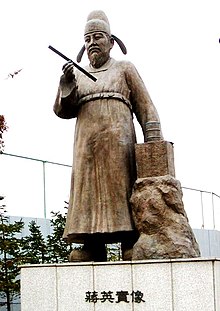Jang Yeong-sil
| Jang Yeong-sil | |
 |
|
| Korean name | |
|---|---|
| Hangul | 장영실 |
| Hanja | 蔣英實 |
| Revised Romanization | Jang Yeong-sil |
| McCune–Reischauer | Chang Yŏngsil |
Jang Yeong-sil (c. 1390 - after 1442) was a Korean scientist and astronomer during the Joseon Dynasty (1392–1897). Although Jang was born as a peasant, King Sejong's (r. 1418–1450) new policy of breaking class barriers placed on the national civil service allowed Jang to work at the royal palace. Jang's inventions, such as the Cheugugi (the rain gauge) and the water gauge, highlight the technological advancements of the Joseon Dynasty.
Jang Yeong-sil's birth is recorded only in the genealogy of the Jang family and in the Annals of the Joseon Dynasty. According to these records, his father, Jang Seong-hwi, was the 8th generation of the Jang family. Jang Seong-hwi was the 3rd of 5 brothers and all of the brothers previously were ministers of Goryeo. There are many historical records about his elder brother, Jang Seong-bal, who was born in 1344 and his grave located at Ui-seong in the province of Gyeongbuk. The Annals state that his mother was a gwangi (gisaeng), thereby their (Yeong-sil's and their mother) social status was a gwanno, (a servant in civil service district courts).
King Sejong the Great of Joseon instituted a policy of selecting officials based on their talent, not by their wealth or social class. Jang's fame gained him entry into the royal court at Hanseong (present day Seoul), where selected commoners displayed their talents before the king and his advisers. Sejong saw that Jang met his expectations in crafts and engineering, and allowed Jang to work as a government official in the palace. The talented scientists recruited under King Sejong's new program worked at the Hall of Worthies (집현전; 集賢殿; Jiphyeonjeon).
Sejong's first assignment to Jang was to build a celestial globe to measure astronomical objects. Books obtained from Arabian and Chinese scholars were not complete in their instructions, for these devices could also be used for military purposes. After two months of study, he made a spherical device that could perform with mediocre accuracy. One year after his first attempt, in 1433, Young-sil made the honcheonui (혼천의, 渾天儀). Honcheonui depended on a waterwheel to rotate the internal globe to indicate time. Whether day or night, this allowed the instrument to be updated on the positions of the sun, moon, and the stars. Later celestial globes (i.e. gyupyo (규표)) could measure time changes according to the seasonal variations. These instruments, along with the sundials and water clocks, were stationed around the Kyonghoeru Pond in Kyongbok Palace and made into use by the astronomers. The success of Jang Yeong-sil's astronomical machines was marked in 1442 AD when the Korean astronomers compiled their computations on the courses of the seven heavenly objects (five visible planets, the sun, and moon) in Chiljeongsan (칠정산).
...
Wikipedia
